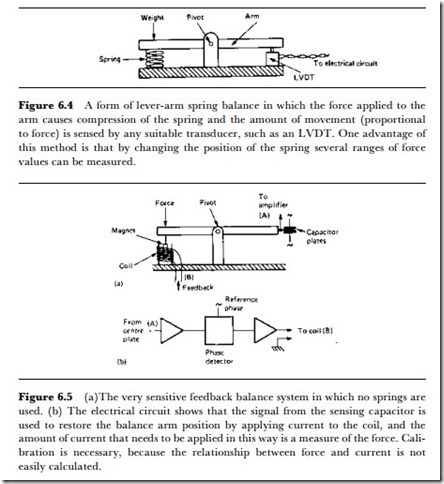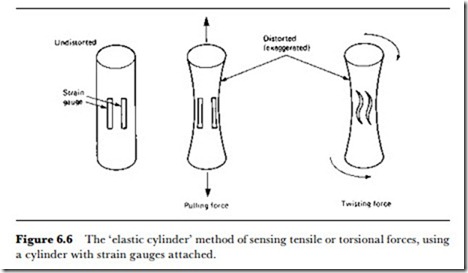Electronic sensors
The mass and volume of solids are quantities that are not easy to sense or measure by electronic methods. The main methods for mass really depend on a weight measurement, but for most purposes this is what is required in any case, since the distinction is academic when you are working on Earth. The available methods make use of strain gauges to measure weight, or position gauges to measure the extension of a spring caused by the weight of a mass.
Figure 6.2 shows the principle of a simple lever-arm weight sensor. The arm is made of an elastic material, in the sense of a material whose change of dimensions will be proportional to the force applied to it. The arm material will usually be metal whose cross-section will be chosen to suit the weights to be measured, which could be in the gram range or in the tonne range, depending on what is to be weighed. A strain gauge, or more likely a pair of strain gauges, is used to obtain an electrical output that is proportional to the amount by which the lever arm is bent. This in turn will be proportional to the weight applied at the end.
Another form of strain-gauge weight sensor is illustrated in Figure 6.3. This consists of a cube of elastic material on which strain gauges have been fastened so as to detect changes in the dimensions. Placing a weight on top of the cube, with the cube resting on a support, will distort the cube, giving
a reading from the strain gauges that will once again be proportional to the amount of weight or force.
Both types of strain-gauge measurement need to use more than one strain gauge because of the effects of temperature. The effect of a small change of temperature on an elastic material is likely to cause more change of dimension than the effect of a modest force, so that some form of temperature compensation is needed. This usually takes the form of multiple strain gauges, and in the lever type of sensor is best achieved by using one gauge on top of the lever and one underneath. A force will cause one gauge to be lengthened and the other shortened, whereas a change of temperature will cause both gauges to be lengthened, so that if the output of one strain gauge is subtracted from the output of the other, the result will be proportional to force and unaffected by temperature changes.
A third form of mass/weight sensor makes use of a balance principle, although the weight of a mass against a strong spring is usually balanced (Figure 6.4). The effect of the force exerted by the mass is to compress the
spring, and this movement can be detected by any of the sensors that were discussed in Chapter 2. A variation on this scheme is illustrated in Figure 6.5. One end of the arm is supported by a light spring, and carries a magnet that is surrounded by a coil. The opposite end of the balance arm forms a capacitive detector, the output from which is amplified and used to provide a current that is circulated through the coil. When the application of a force tries to deflect the arm, the deflection produces a signal at the capacitive sensor, and the output current acts on the magnet so as to restore the original position of the arm. Because of the very large negative feedback, the movement of the balance arm is always very small, so that the linearity of measurement can be good. The force need not be applied directly to the end of the arm, so that a large range of forces can be catered for by making the point of application of the force variable.
For tensile forces (which are pulling forces), an adaptation of the basic strain-gauge design is illustrated in Figure 6.6. This uses an elastic rod or tube that will be distorted when a tensile force is applied, causing an output from the strain gauges. As before, multiple strain gauges are used in order to reduce the effects of temperature changes.
The volume of a solid is not easily amenable to direct electronic measurement. The principle of displacement, however, allows indirect sensing of volume, because when a solid is completely immersed in a liquid it displaces an amount of liquid equal to its own volume. A change of liquid level, which is proportional to a change of liquid volume, can be sensed and this reading used as a measure of the volume of the solid. A displacement method of this type is valid only to the extent to which water, or whatever liquid is used, can completely surround the object, leaving no air-filled cavities. In the case of a porous material, it also depends on the extent to which the liquid can permeate the pores. The liquid must not have any chemical reaction with the solid whose volume is to be measured, and the solid must not be soluble in the liquid. Since the bulk density of all materials is known (or measurable from samples) it is often considerably more accurate to find the mass of a material and calculate its volume as mass divided by density (using units of kg for mass and kg/m3 for density to get volume in units of m3). See later in this chapter for a description of liquid level sensors.


